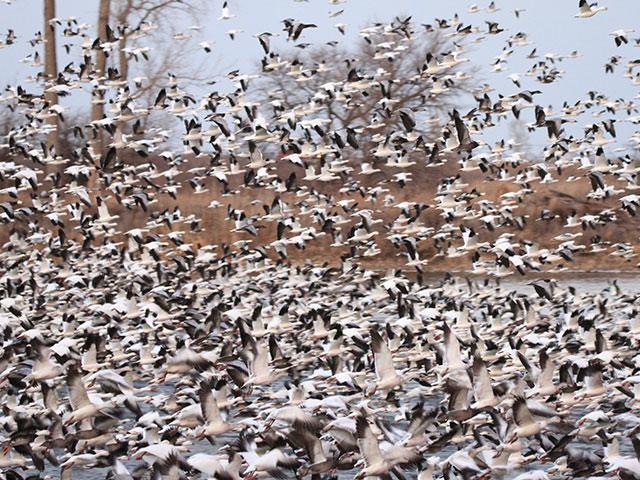Bird Flu Numbers Keep Rising
State Vet: Bird Flu Becoming Endemic as Millions More Birds Affected in Past Month
HURON, S.D. (DTN) -- Driving east along rural highways in South Dakota, flocks of snow geese are seen across the skies and taking a break in cornfields.
Over the past month, that waterfowl migration has led to a new spike in highly pathogenic avian influenza (HPAI) cases, or bird flu, that has led to larger commercial operations being hit and the depopulation of at least 7.6 million birds.
In the last 30 days, there have been 94 confirmed cases of bird flu spread across 26 states, USDA reported. A handful of large egg-laying operations in Iowa and Ohio have driven up the numbers.
"The virus has established itself in the wild waterfowl population," said Beth Thompson, South Dakota's state veterinarian. "There are a lot of snow geese and Canadian geese going right over the state of South Dakota and Minnesota right now. There are a lot of other migratory birds traveling in different parts of the country, too. The virus is passing through all of those birds."
She added, "This has been a devastating disease for the poultry industry."
Unlike 2014 and 2015, this version of bird flu shows no signs of going away. "This is a different strain of flu than we saw in 2015," she said.
Thompson told members of the South Dakota Farmers Union on Thursday the strain of H5N1 virus keeps adapting itself to become endemic -- a regularly occurring virus attacking domestic turkeys and poultry.
P[L1] D[0x0] M[300x250] OOP[F] ADUNIT[] T[]
"I would argue, and we've had these discussions with USDA's Veterinary Services, that this is actually endemic at this point," she said. "It's established itself in migratory waterfowl and we're seeing it across the year in the United States. There is something new and different that we need to do with this disease to help our farmers. What that is, I'm not quite sure."
As those migratory birds come together, Thompson said, "That virus is modifying itself just a little bit."
She compared it to influenza in humans that tweaks itself just enough to require changes in the annual flu shots people receive. "That's exactly what's happening with this virus."
USDA started vaccine trials for bird flu last spring. Last month, the European Union also began looking at the potential of an HPAI vaccine because its poultry industry continues to be hit hard by the virus. Still, animal vaccines raise multiple trade issues. USDA, for instance, is testing vaccines but also restricted poultry imports from France and the European Union after the French began vaccinating ducks against HPAI.
Meanwhile, the virus continues to strike individual operations differently than in 2014 and 2015. Thompson noted the earlier outbreak showed workers and feed companies had helped spread the disease from farm to farm in 2014-15. This time around, there are no similar linkages.
"We know the farmers and people working on the farms aren't tracking the virus, but somehow it is still getting into the barns and that is the puzzle that we are still trying to figure out," Thompson said.
Last week, Iowa officials reported a commercial egg-laying operation in Sioux County in northwest Iowa was infected involving more than 1.6 million chickens. A few days earlier, another egg-laying operation in Ohio was infected with nearly 1.35 million chickens.
Iowa leads the nation in lost commercial birds over the past month with just two egg-laying operations accounting for more than 2.7 million chickens that had to be depopulated. Along with the Sioux County operation, another operation with 1.12 million chickens was infected in Taylor County in south-central Iowa.
Canadian officials also have reported 81 cases this fall -- 67 in the past month -- involving 9.6 million birds. Most of the Canadian cases reported are concentrated in Alberta and British Columbia.
In South Dakota, the state had 26 farms hit involving nearly 700,000 birds infected. In recent days, more backyard flocks have been affected.
"Just in the last week or two, we've had a couple in South Dakota and they may range from a couple of roosters and a handful of hens to people with ducks or people with peacocks," Thompson said. "All of those different species have been affected by this virus."
As migration continues, Thompson added, "I don't doubt we're going to see more cases in South Dakota."
Nationally, since this outbreak began in early 2022, bird flu has struck at least 973 flocks in 47 states and affected just under 68 million domestic birds.
USDA updates on HPAI: https://www.aphis.usda.gov/…
Chris Clayton can be reached at Chris.Clayton@dtn.com
Follow him on X, formerly known as Twitter, @ChrisClaytonDTN
(c) Copyright 2023 DTN, LLC. All rights reserved.




